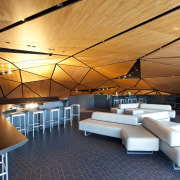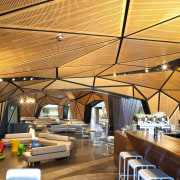Grounded
Many modern airport terminals reference the nature of flight. This terminal building does the opposite, presenting three rock-like structures that are anchored to the landscape
For many years, there has been a certain architectural predictability to new airport terminal buildings. Structures with soaring roof lines and expansive windows have been the norm rather than the exception.
It's a concept that has been turned on its ear with the Rock the new fractured, copper-clad Wellington International Airport terminal building that was built to cope with increased traffic. Architects Marcellus Lilley of Studio Pacific Architecture and Ralph Roberts of Warren and Mahoney acknowledge the design is a radical departure from what has gone before.
"It is the polar opposite to contemporary airports both worldwide and within New Zealand, which are preoccupied with the imagery of flight," says Roberts. "The concept of a crusty, enigmatic rock form perched on the runway is provocative and daring. But the design was never intended to be about flight imagery. Rather, the building represents a haven, anchored and embedded in the land."
Lilley says Wellington International Terminal specifically requested an edgy building that would push the design boundaries.
"It needed to make a strong statement and be a defining entry to Wellington," he says. "The airport wanted a challenging building that would be an experience for travellers. But it also needed to integrate with the existing buildings, and fit within a restricted space with an uneven boundary line between air side and land side."
Lilley says the final design emerged from a series of workshops, presentations and conversations about what the building should represent.
"It needed to reflect Wellington's unique geology, its exposure to the wind, the coastline, and its toughness and ruggedness. The idea of a rock form evolved from these discussions, and we were encouraged to explore this further," says Roberts. "The design was never intended to be an artificial stereotype. This was not about theming ideas. We did not want it to be literal."
The final form comprises three linked structures two large copper-clad volumes and a lower black bitumen-clad rock form that accommodates ramps linking the airbridges with the main building. The fractured form of the structures is enhanced by a black roofing membrane system that breaks up the copper panels, much like geological strata layers. These membranes also have a functional role as gutters and rain-screen waterproofing.
"The geometry of these two volumes is different, which creates a visual tension that you wouldn't get with a typical structural alignment," says Roberts.
The solidity of the rock forms is reflected in their thickness partly determined by the need for a double-skin roof cavity space and to accommodate services.
The two main volumes are linked by a glazed fissure that extends across the roof and down to ground level, bringing natural light into the centre of the building. There are also long windows, like slices cut out of the rock, positioned to frame key views of the runway and aprons.
The rock formation continues on the interior, with the copper wrapping around to semi-enclose each volume. The copper was pre-weathered at the airport to create the patina visible on the interior panels. However, the exterior panels will continue to weather, eventually gaining a green patina.
"The black exterior of the lower ramp rock also extends inside," says Lilley. "But here it is clad in black tiles, rather than the bituminous membrane."
Large macrocarpa wood veneer panels line the ceilings of the two main structures that enclose the departure lounges and cafe facilities.
"The ceiling is articulated as a series of triangular panels that accommodate the geometry of the volumes," says Lilley. "They don't mimic the strata on the outside. We wanted the interior to provide a whole new experience."
Each triangular panel is highlighted by negative detailing, so the panels appear to sit proud of the black background. These recessed areas accommodate services clusters for the lighting.
"This meant we could retain the purity of the macrocarpa," says Roberts. "There are no holes punched through the wood for the lights. However, some of the panels are slotted for low-velocity air conditioning.
"The timber exudes plenty of visual warmth, so the whole building is captivating and intimate. It resounds with personality, in contrast to the bland halls that typify most international airports with their mall-like interiors. Spaces unfold on varying levels, encouraging exploration."
Credit list
Architect
Structural and civil engineer; project manager
Acoustic engineer
Aeronautical engineer
Main contractor
Roofing
Interior glazing
Hardware
Ceiling panels
Electrical subcontractor
Project director
Mechanical services and fire engineer
Facade engineer
Quantity surveyor
Copper cladding
Windows
Joinery
Stone and tiling
Furniture
Mechanical subcontractor
Story by: Colleen Hawkes
Home kitchen bathroom commercial design
Emotion through engineering
Best of both worlds – Behind the scenes of an award-winning bathroom
Tropical escape
















